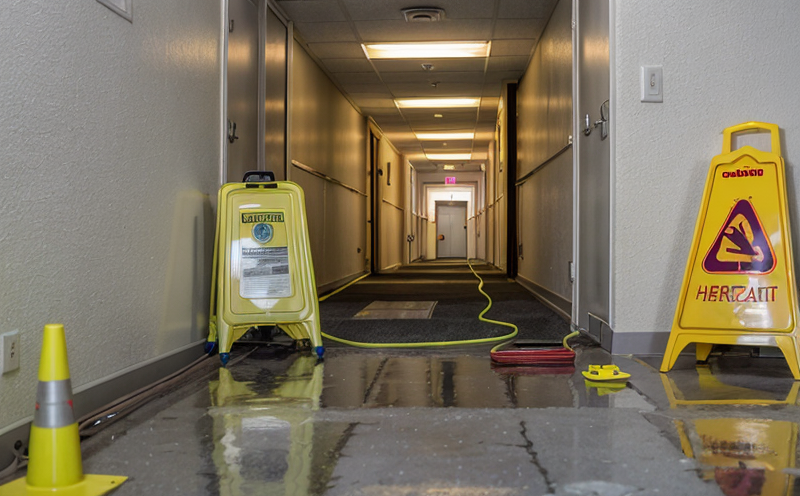CSA C22 2 No 157 Intrinsically Safe Testing for Hazardous Locations
The CSA C22.2 No. 157 standard is a critical component in the design, testing, and certification of electrical equipment intended for use in hazardous locations. This standard ensures that devices meet stringent requirements to prevent ignition sources from initiating explosions or fires within potentially explosive atmospheres such as those found in oil refineries, chemical plants, and petrochemical facilities.
The intrinsic safety (IS) concept is based on the principle of limiting energy levels so that any electrical spark produced by a device cannot ignite an explosive atmosphere. This approach involves controlling both voltage and current to ensure that they fall below ignition thresholds for common hazardous gases like methane or hydrogen.
For electronic equipment, this typically means using specialized components such as resistors, capacitors, and diodes designed to operate safely under the conditions specified by CSA C22.2 No. 157. Testing these components involves simulating real-world operating environments to ensure they function correctly without generating hazardous sparks or arcs.
The standard covers various aspects of intrinsically safe equipment including:
- Component selection
- Power supply design
- Circuit layout considerations
- Environmental testing for temperature, humidity, and shock
To meet the requirements set forth by CSA C22.2 No. 157, manufacturers must conduct rigorous testing at independent laboratories like ours. Our facility utilizes advanced instrumentation capable of replicating the exact conditions under which devices will be used in hazardous locations. This includes specialized chambers designed to mimic atmospheric pressures and temperature ranges typical of industrial settings.
Our team of experts follows all relevant international standards including IEC 60079-14, which provides additional guidance on testing for intrinsic safety. By adhering strictly to these guidelines, we ensure that our clients receive accurate results that can be relied upon when seeking certification from regulatory bodies such as the Canadian Standards Association (CSA).
Testing procedures typically involve:
- Initial inspections and documentation
- Component level tests
- System integration testing
- Final acceptance testing
Throughout this process, our laboratory adheres to rigorous quality control measures to guarantee consistent accuracy across all tests conducted. This commitment to excellence has earned us a reputation as one of the leading providers of hazardous location testing services worldwide.
In summary, CSA C22.2 No. 157 Intrinsically Safe Testing ensures that electrical equipment used in hazardous locations meets strict safety criteria designed to prevent explosions and fires caused by electrical sparks or arcs. By leveraging our expertise and state-of-the-art facilities, we provide comprehensive testing solutions tailored specifically for this challenging application area.
Why It Matters
The importance of CSA C22.2 No. 157 intrinsically safe testing cannot be overstated when dealing with hazardous locations. These areas present unique challenges due to the presence of potentially flammable or explosive materials, making it imperative that all equipment used in such environments is certified as safe.
Failure to comply with these standards can lead to serious accidents resulting in loss of life and extensive property damage. Regulatory authorities worldwide enforce strict regulations governing the use of electrical equipment within hazardous zones, with non-compliance often leading to fines or even bans on certain products.
In addition to legal requirements, there are broader implications associated with failing to meet these standards. Poorly designed or improperly tested devices could pose significant risks not only to personnel but also to nearby communities located close to industrial facilities where hazardous materials are stored and processed.
- Personnel Safety: Properly certified equipment minimizes the risk of accidental ignition, thereby protecting workers from life-threatening situations.
- Environmental Protection: By preventing explosions or fires within hazardous areas, we reduce the likelihood of environmental contamination caused by spills or leaks during emergency response operations.
- Economic Impact: Ensuring compliance helps maintain good relations with regulatory bodies and ensures smooth business operations without disruptions due to non-compliance issues.
In conclusion, adhering to CSA C22.2 No. 157 intrinsically safe testing is essential for maintaining both safety standards and operational integrity in hazardous locations. It plays a crucial role in safeguarding lives, protecting the environment, and facilitating efficient industrial processes across various sectors.
Benefits
The benefits of complying with CSA C22.2 No. 157 intrinsically safe testing extend beyond mere regulatory compliance; they offer substantial advantages that contribute to overall business success in the electronics industry, particularly within hazardous locations. Here are some key benefits:
- Enhanced Safety: By ensuring that equipment meets stringent intrinsic safety requirements, businesses can significantly reduce risks associated with electrical ignition sources.
- Regulatory Compliance: Meeting these standards guarantees adherence to international and national regulations, avoiding potential legal penalties or product bans.
- Reputation Enhancement: Demonstrating a commitment to quality assurance through rigorous testing enhances brand reputation among customers and stakeholders.
- Operational Efficiency: Reliable equipment reduces downtime due to failures, improving overall productivity and efficiency within hazardous operations.
- Risk Management: Implementing intrinsic safety measures helps identify potential hazards early, allowing for proactive risk mitigation strategies.
- Customer Confidence: Providing certified products instills trust in customers regarding the reliability and safety of purchased equipment.
In essence, CSA C22.2 No. 157 intrinsically safe testing offers more than just a compliance requirement; it represents an investment in safety, efficiency, and reputation that translates into long-term business benefits.





